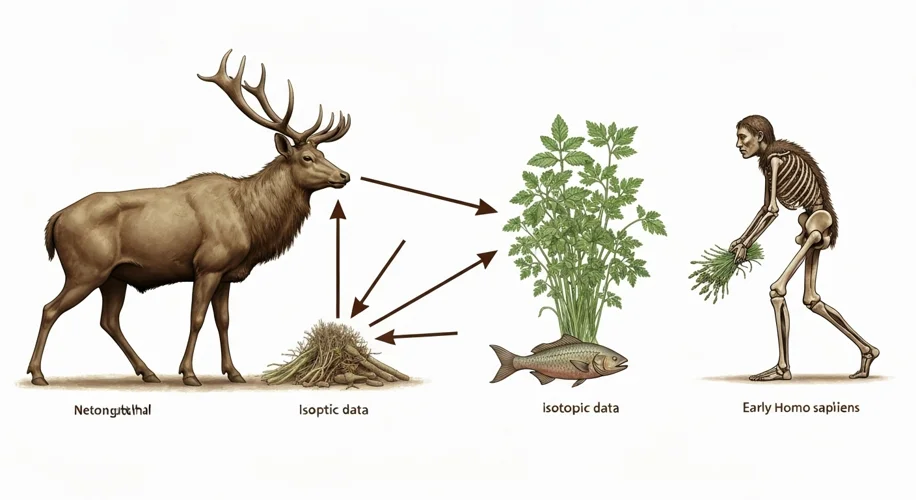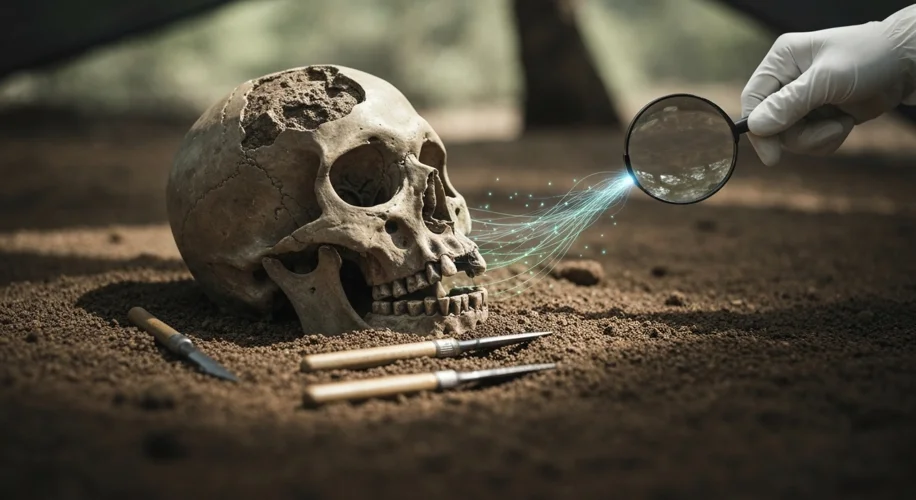Imagine a world millions of years ago, a time when the very definition of ‘human’ was still taking shape. Our ancestors, and their close cousins the Neanderthals, roamed landscapes vastly different from our own. What did they eat? How did they survive? For centuries, these questions lingered, shrouded in the mists of time, with only fragmented clues from fossilized bones and stone tools to guide us.
But now, a scientific detective story is unfolding, one that uses the invisible signatures left behind in the very building blocks of life to reconstruct ancient diets. This powerful technique, known as stable isotope analysis, is rewriting our understanding of prehistoric survival, revealing a nuanced picture of what our ancient human and Neanderthal relatives truly consumed.
Think of your bones and teeth as tiny time capsules. As you eat, specific elements from your food become incorporated into your body tissues. Among these elements are isotopes – variants of an element with a different number of neutrons. Some isotopes are “heavy” and some are “light,” and their relative proportions in your tissues can tell us a great deal about your diet over time.
For instance, the isotopes of carbon (¹³C and ¹²C) can reveal whether an organism primarily consumed plants (terrestrial or marine) or animals. Nitrogen isotopes (¹⁵N and ¹⁴N) offer clues about the trophic level, indicating if an individual ate plants, herbivores, or carnivores higher up the food chain. Sulfur and oxygen isotopes can even provide insights into the environment and water sources.

The process involves meticulously collecting tiny samples from fossilized teeth and bones. These samples are then subjected to complex chemical and physical analyses in specialized laboratories. The ratios of different isotopes are measured with incredible precision, and these ratios are then compared to known isotopic values of various food sources and environmental proxies. It’s like deciphering a hidden code, where each isotopic signature tells a part of the story.
Consider the groundbreaking work done on Neanderthal remains. For years, the prevailing view often painted Neanderthals as purely carnivorous, solely focused on hunting large game. However, stable isotope analysis has painted a more complex picture. Studies of Neanderthal teeth, for example, have revealed a more varied diet than previously thought. In some instances, Neanderthals consumed plants, seeds, and even shellfish, suggesting a more opportunistic and adaptable approach to their subsistence strategies.
One remarkable study analyzed Neanderthal remains from sites like El Sidrón in Spain. The isotopic data indicated that these Neanderthals were consuming a significant amount of plant matter, including tubers and possibly grains. This discovery challenged the long-held stereotype of the Neanderthal as a blunt-wielding, meat-eating brute, revealing them as more resourceful and versatile foragers.
Similarly, isotope analysis on early Homo sapiens fossils from Africa and Eurasia has provided crucial data on their dietary shifts and adaptations. As humans migrated and encountered new environments, their diets evolved. We see evidence of marine resource utilization in coastal populations, while inland groups relied on a broader spectrum of terrestrial animals and plants. These dietary shifts were not just about survival; they were intrinsically linked to cognitive development, physiological adaptations, and the very evolution of our species.

What’s particularly fascinating is how this technique allows us to compare and contrast the diets of different hominin species living in the same time and place. By analyzing isotopes from both Neanderthal and contemporary Homo sapiens fossils found at the same archaeological sites, scientists can infer competition for resources or, conversely, complementary dietary strategies. This opens a window into the complex ecological interactions that shaped our evolutionary past.
The implications of stable isotope analysis extend beyond just diet. By examining isotopes in animal bones found alongside human or Neanderthal remains, researchers can reconstruct the entire paleo-ecosystem. This provides context for the food choices made by our ancestors, revealing the types of environments they inhabited and the availability of different food sources.
For instance, sulfur isotope ratios can indicate whether an animal grazed in a specific type of grassland or forest, and oxygen isotopes can shed light on water sources, offering clues about local climate and landscape. This holistic approach allows us to understand not just what our ancestors ate, but why they ate it, and the environmental pressures that influenced their choices.
As analytical techniques become even more refined, and as more fossil evidence is discovered, stable isotope analysis promises to unlock even deeper secrets about our ancient past. It’s a testament to human ingenuity, a method that transforms inert bone into a vibrant narrative of survival, adaptation, and the fundamental drive to eat, to thrive, and to evolve.
So, the next time you look at a fossil, remember that it’s not just a relic of a bygone era. It’s a sophisticated biological record, waiting for the right scientific tools to reveal the hidden stories of what our ancient ancestors truly had for dinner.

